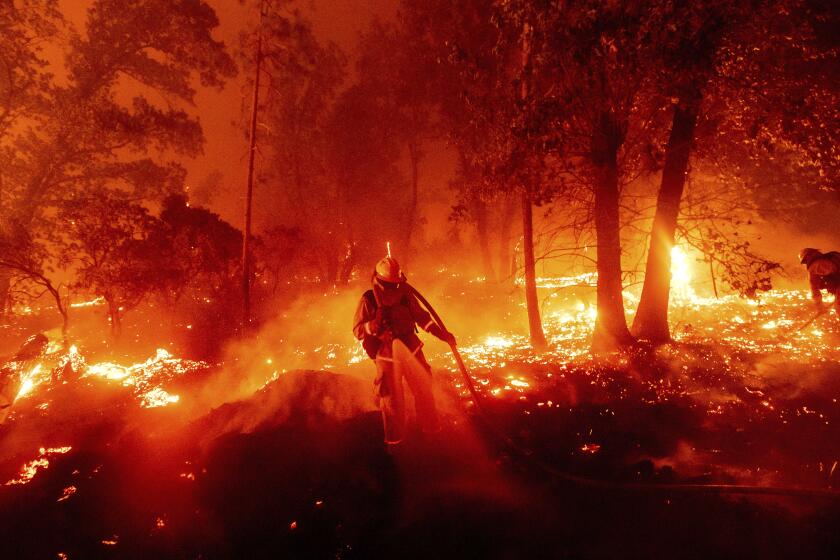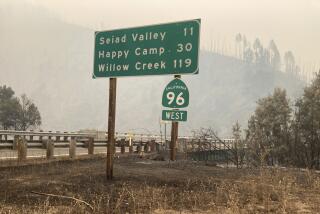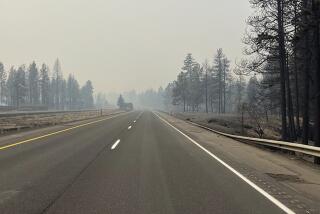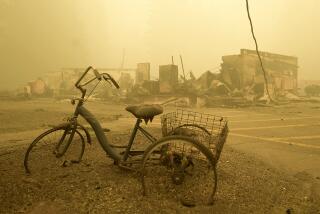Climate change brings Santa Ana-like winds and explosive wildfires to Oregon
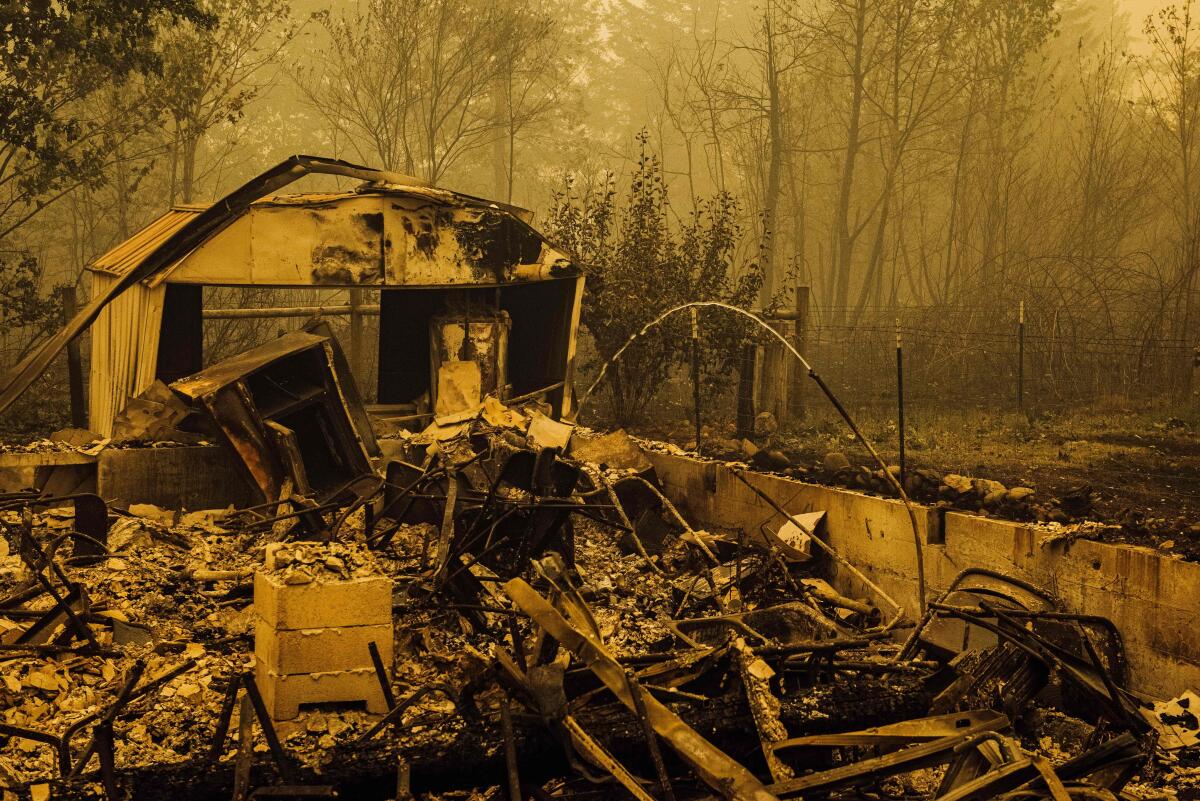
- Share via
EUGENE, Ore. — Nearly nine months pregnant, Elisha Goodrick was cooking chicken piccata Monday evening when she noticed something eerie — weather like she had never experienced in western Oregon.
It was strange enough to see ash falling like snow outside her kitchen window as a wildfire galloped through mountainsides somewhere above.
But what alarmed her was the pounding on the roof as an extraordinary wind raged in the tops of Douglas firs, raining branches on the blue-shingled house.
It wasn’t long before a volunteer-firefighter friend called.
“Get out now,” he said.
The Holiday Farm fire was quickly approaching their little town of Rainbow. Goodrick grabbed her hospital go-kit. Her fiance, James Rethaford, seized a diaper bag and a favorite quilt stitched by his late grandmother.
They loaded their year-old son, Korbin, into their old Buick and raced west down the valley toward Eugene.
“We didn’t wait for the Level 3 warning, we just took off,” said Rethaford, sitting on a cooler Wednesday in front of an evacuation center. “I’m 95% sure the house is gone.”
As for the roaring winds that night, scientists say that they were the equivalent of the notorious Santa Anas of Southern California.
Their rare appearance in the rainforests of the Pacific Northwest is almost certainly due to climate change, according to researchers.
And like the winds that race down the mountainsides near Los Angeles each fall, gaining heat and fanning the flames as they go, the gales that struck Oregon over the weekend have turned small fires into infernos.
The state is experiencing its worst fires in memory, with at least three deaths — including a woman and her 13-year-old grandson — and swaths of two small cities — Phoenix and Talent — burned to the ground.
Hundreds of homes and other structures have been destroyed. Skies have turned bright orange or dark gray across the western part of the state, which is experiencing some of the worst air quality ever recorded.
On Thursday, 39 separate fires burned across the state, including one that forced evacuations as it reached cities on Portland’s outskirts.
Oregon Gov. Kate Brown, who is seeking federal disaster aid, is bracing residents for bad news as crews start to reenter burned communities to assess the damage.
“We have never seen this amount of uncontained fire across the state,” Brown said during a Thursday news conference. “Thousands of people loaded their cars with precious belongings, pets and as much as they could possibly carry.”
Larry O’Neill, the state climatologist, said in an interview that the winds Oregon experienced are almost unheard of this time of year.
“There’s a sense of complacency because we don’t get the Santa Ana-type winds, so you don’t check fire weather or think about it so much when you move into one of these forested areas,” he said. “People still have this idea that western Oregon is a rainforest, so it wouldn’t happen like in California where they build in dangerous areas and should know better.”
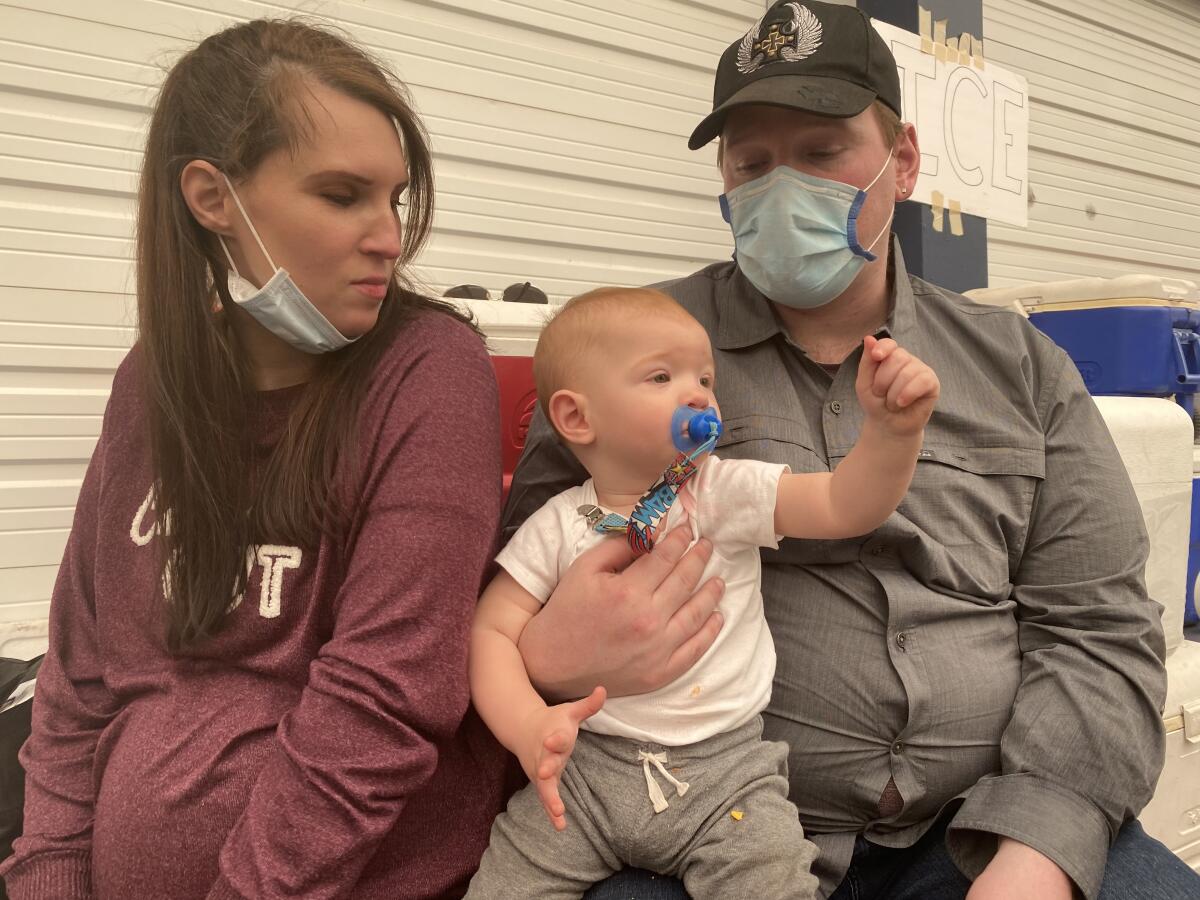
The weirdness began on Monday when swings in the jet stream sent temperatures in Colorado plummeting more than 55 degrees overnight and produced a rare summer snowstorm.
Moving from higher-pressure areas to lower ones, warm air rushed north across a vast stretch of the West.
Hot dry air that had accumulated to the east of the Cascade mountains in Oregon crested the range and raced down western flanks and foothills into the Willamette Valley. Physics dictates that air warms about 5 degrees for every 1,000 feet of descent.
“This is a key ingredient for explosive fire growth,” O’Neill said.
“Firefighters typically count on a slowing of fire growth at night when they have to suspend air operations,” he said. “But without the normal cooling as relative humidity goes up, the fires just absolutely explode.”
Studies show that the shift in the jet stream and the Santa Ana-type winds are consistent with climate change, he said.
“Climate change is not an abstract concept anymore,” he said. “This is what it looks like.”
Completing the equation of disaster, the winds drove flames into areas of western Oregon that had been experiencing severe drought — including Rainbow, a town so small it is not counted separately in the U.S. census.
Six of the 20 largest wildfires the state has ever seen started in the last few weeks, Cal Fire says.
John Bailey, a forestry expert at Oregon State University, has hiked in the woods around the town, admiring towering firs, songbirds and the rushing McKenzie River.
He said decades of fire suppression, as well as severe cutbacks in logging, had created a buildup of fuel — downed logs, grass, shrubs and duff — that he had predicted would someday power catastrophic fires.
Rethaford and his family moved there a year ago from the Oregon coast and rented a house from his father, Troy Rethaford.
The night they evacuated, his father ran out after them, asking why they were leaving so soon, but an hour and a half later, as massive flames appeared over the ridge, he fled as well.
The Holiday Farm fire tore down the McKenzie River valley and into the town of Blue River, home to about 800 people six miles west of Rainbow.
Firefighters had to cut their way through fallen trees as they drove east into the area — debris that could have trapped people who failed to get out early.
Sections of Blue River were razed. The full extent of destruction in Rainbow remains unknown, as does the cause of the fire, which was still fully uncontained Thursday evening.
Goodrick, 33, Rethaford, 31, and their son spent Monday night in their car, sleeping little.
They eventually found their way to a high school stadium in Springfield, Ore., where a stream of vehicles dropped off donated food and supplies. The Red Cross booked the family a room in a motel, where they spread out donated toys for Korbin.
The couple’s biggest regret was leaving behind their engagement and wedding rings, and Goodrick’s wedding dress, for a ceremony that had been delayed by the coronavirus pandemic.
Rethaford, who is unemployed, worried about supporting his growing family, perhaps without a house.
After Hurricane Katrina in 2005, Rethaford traveled with his church group to Louisiana, where members helped to rebuild a man’s house.
“Now I’m seeing it from the other side,” he said.
More to Read
Sign up for Essential California
The most important California stories and recommendations in your inbox every morning.
You may occasionally receive promotional content from the Los Angeles Times.
